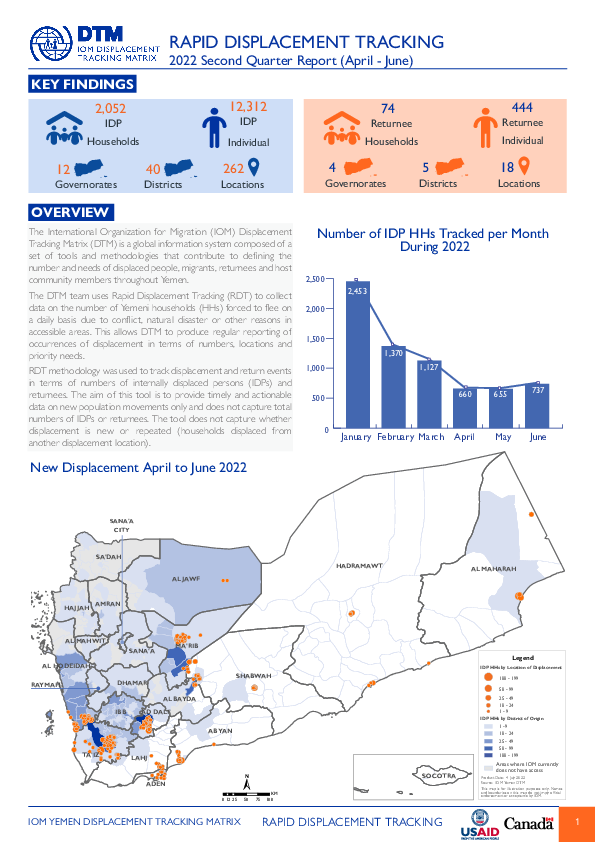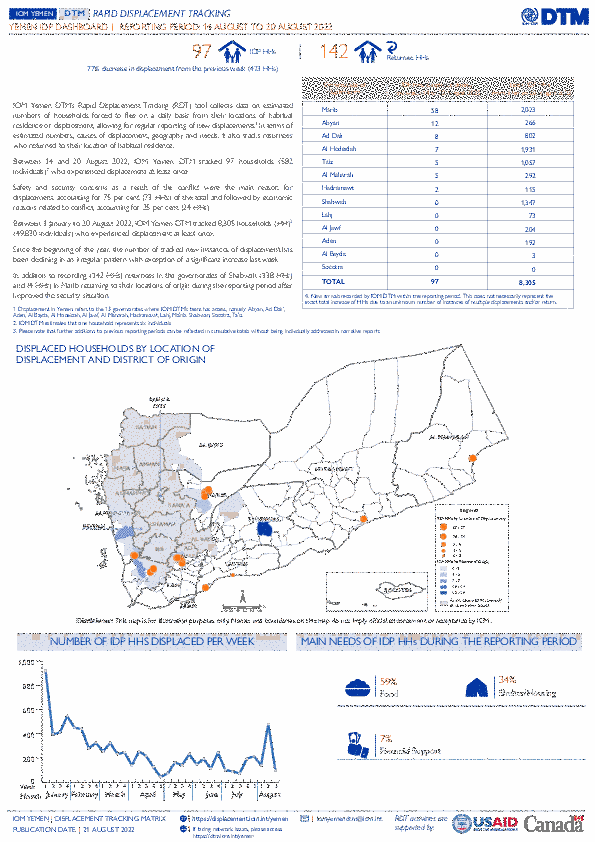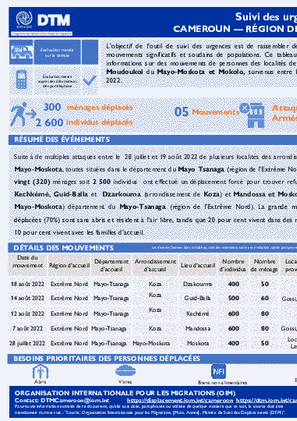-
Countries
-
Data and Analysis
-
Special Focus
-
Crisis Responses

Contact
DTM Yemen, iomyemendtm@iom.int
Language
English
Location
Yemen
Period Covered
Apr 01 2022
Jun 30 2022
Activity
- Mobility Tracking
During the reporting period, between 1 April to 30 June 2022, IOM Yemen DTM tracked 2,052 households (HH) (12,312 Individuals) who experienced displacement at least once compared to 4,950 households in the first quarter. This represents a decrease of 59 per cent. Since the beginning of the reporting period, the number of tracked new instances of displacement has been declining steadily due to the parties of the conflict entering a truce that began on the second day of April.
Safety and security concerns as a result of the conflict were the main reason for displacement, accounting for 79 per cent (1,618 HHs) of the total, followed by economic reasons related to conflict, accounting for 21 per cent (434 HHs).
The majority of people moved into/within the following governorates and districts:
- Marib (501 HHs) – Marib City (324 HHs), Marib (141 HHs), Harib (36 HHs) districts. Most displacements in the governorate originated from within Marib (36%) and from Al Hodeidah (12%).
- Al Hodeidah (363 HHs) – Hays (281 HHs), Al Khukhah (77 HHs), At Tuhayta (5 HHs) districts. Most displacements in the governorate originated from within Al Hodeidah (66%) and from Taiz (33%).
- Ad Dali (352 HHs) – Qatabah (195 HHs), Ad Dali (146 HHs), Al Hasayn (11 HHs) districts. Most displacements in the governorate originated from within Ad Dali (43%) and from Ibb (21%).
The majority of people moved from the following governorates and districts:
- Al Hodeidah (543 HHs) – Hays (238 HHs), Zabid (36 HHs), At Tuhayta (36 HHs) districts.
- Taiz (464 HHs) – Maqbanah (177 HHs), Al Maafer (69 HHs), Jabal Habashi (43 HHs) districts.
- Marib (253 HHs) – Al Jubah (79 HHs), Harib (71 HHs), Jabal Murad (21 HHs) districts.
Between 1 January and 30 June 2022, IOM Yemen DTM tracked 7,002 households (42,012 individuals) displaced at least once.

Contact
DTM Yemen, iomyemendtm@iom.int
Language
English
Location
Yemen
Period Covered
Aug 14 2022
Aug 20 2022
Activity
- Mobility Tracking
IOM Yemen DTM’s Rapid Displacement Tracking (RDT) tool collects data on estimated numbers of households forced to flee on a daily basis from their locations of origin or displacement, allowing for regular reporting of new displacements in terms of estimated numbers, geography, and needs. It also tracks returnees who returned to their location of origin.
From 1 January to 20 August 2022, IOM Yemen DTM tracked 8,305 households (HH) (49,830 Individuals) who experienced displacement at least once.
Between 14 and 20 August 2022, IOM Yemen DTM tracked 97 households (582 individuals) displaced at least once. The majority of people moved into/within the following governorates and districts:
- Marib (58 HHs) – Marib City (39 HHs), Marib (19 HHs) districts. Most displacements in the governorate originated from Shabwah and Marib.
- Abyan (12 HHs) – Khanfar (12 HHs) district. Most displacements in the governorate originated from Al Hodeidah.
- Ad Dali (8 HHs) – Ad Dali (4 HHs), Qatabah (4 HHs) districts. Most displacements in the governorate originated from Ad Dali and Al Hodeidah.
The majority of people moved from the following governorates and districts:
- Shabwah (24 HHs) – Ataq (23 HHs), Osaylan (1 HH) districts.
- Al Hodeidah (21 HHs) – Bayt Al Faqih (8 HHs), Jabal Ras (4 HHs), Hays (3 HHs) districts.
- Taiz (20 HHs) – Maqbanah (8 HHs), At Taiziyah (2 HHs), Mawza (2 HHs) districts.
Contact
DTM Yemen, iomyemendtm@iom.int
Location
Yemen
Activity
- Mobility Tracking
- Event Tracking
Period Covered
Aug 14 2022 -Aug 20 2022
From 1 January to 20 August 2022, IOM Yemen DTM tracked 8,305 households (HH) (49,830 Individuals) who experienced displacement at least once.
Between 14 and 20 August 2022, IOM Yemen DTM tracked 97 households (582 individuals) displaced at least once. The majority of people moved into/within the following governorates and districts:
- Marib (58 HHs) – Marib City (39 HHs), Marib (19 HHs) districts. Most displacements in the governorate originated from Shabwah and Marib.
- Abyan (12 HHs) – Khanfar (12 HHs) district. Most displacements in the governorate originated from Al Hodeidah.
- Ad Dali (8 HHs) – Ad Dali (4 HHs), Qatabah (4 HHs) districts. Most displacements in the governorate originated from Ad Dali and Al Hodeidah.
- Shabwah (24 HHs) – Ataq (23 HHs), Osaylan (1 HH) districts.
- Al Hodeidah (21 HHs) – Bayt Al Faqih (8 HHs), Jabal Ras (4 HHs), Hays (3 HHs) districts.
- Taiz (20 HHs) – Maqbanah (8 HHs), At Taiziyah (2 HHs), Mawza (2 HHs) districts.
Population Groups
Survey Methodology
Unit of Analysis Or Observation
Type of Survey or Assessment
Keywords
Geographical Scope
Administrative boundaries with available data
The current dataset covers the following administrative boundaries

Contact
DTMUkraine@iom.int
Language
Ukrainian
Location
Ukraine
Period Covered
Aug 08 2022
Aug 19 2022
Activity
- Baseline Assessment
Починаючи з 24 лютого 2022 року війна в Україні спричинила безпрецедентну гуманітарну кризу в усіх адміністративних підрозділах (областях) країни.
З 8 по 19 серпня Міжнародна організація з міграції (МОМ) провела базову оцінку території 954 громад, які приймають зареєстрованих внутрішньо переміщених осіб у 21 області та в місті Києві, щоб отримати загальне уявлення про внутрішнє переміщення.
Проведення цієї оцінки підтримує цільове призначення та надання гуманітарної допомоги постраждалому населенню і служить попереднім джерелом для виявлення громад з високим рівнем переміщення.

Contact
DTMUkraine@iom.int
Language
English
Location
Ukraine
Period Covered
Aug 08 2022
Aug 19 2022
Activity
- Baseline Assessment
Starting on 24 February 2022, the war in Ukraine triggered an unprecedented humanitarian crisis across the country. Between 8 and 19 August the International Organization for Migration (IOM) conducted an Area Baseline assessment of 954 hromadas* hosting IDPs in 21 oblasts and Kyiv city in order to gather initial trends on the number and precise geographic location of officially recorded internally displaced persons.
This routine assessment supports the targeting and provision of humanitarian assistance to the affected population and serves as a key source to identifying oblasts and hromadas hosting high numbers of IDPs.
IOM compiled information on more than 3,000,000 IDPs in the 21 oblasts (in addition to Kyiv City) covered by Round 10 of DTM Area Baseline.

Contact
DTM Cameroon, DTMCameroun@iom.int
Language
French
Location
Cameroon
Period Covered
Jul 28 2022
Aug 19 2022
Activity
- Mobility Tracking
- Event Tracking
L’objectif de l’outil de suivi des urgences est de rassembler des informations sur les mouvements significatifs et soudains de populations. Ce tableau de bord présente des informations sur des mouvements de personnes des localités de Moutsikar, Bigdé et Moudoukoi du Mayo-Moskota et Mokolo, survenus entre le 28 juillet et 19 août 2022.

Contact
DTM Guinée, oimguineedtm@iom.int
Language
French
Location
Guinea
Period Covered
Jul 01 2022
Jul 31 2022
Activity
- Flow Monitoring
Le suivi des flux, qui est mis en œuvre en étroite collaboration avec les autorités et des partenaires nationaux et locaux, est composé de deux outils: l’enregistrement des flux (Flow Monitoring Registry, FMR) et les enquêtes individuelles (Flow Monitoring Survey, FMS). Il récolte des données clés sur les flux migratoires, les profils des voyageurs et les parcours et intentions des migrants, afin de fournir une meilleure compréhension des flux migratoires dans la région.
Ce rapport présente les données obtenues à travers le FMR pendant le mois de juillet 2022 au niveau des FMP de Boundoufourdou (préfecture de Koundara) dans le nord du pays, de Kourémalé et Nafadji (préfecture de Siguiri) dans le nord-est de la Guinée.
Contact
DTMUkraine@iom.int
Location
Ukraine
Activity
- Mobility Tracking
- Baseline Assessment
Period Covered
Aug 08 2022 -Aug 19 2022
A baseline assessment is a sub-component of mobility tracking. It aims to collect data on IDP, migrant or returnee population presence in a defined administrative area of the country.
Population Groups
Survey Methodology
Unit of Analysis Or Observation
Type of Survey or Assessment
Keywords
Geographical Scope
Administrative boundaries with available data
The current dataset covers the following administrative boundaries
Contact
DTMUkraine@iom.int
Location
Ukraine
Activity
- Mobility Tracking
- Baseline Assessment
Period Covered
Aug 08 2022 -Aug 19 2022
A baseline assessment is a sub-component of mobility tracking. It aims to collect data on IDP, migrant or returnee population presence in a defined administrative area of the country.
This is a restricted dataset. To get access, kindly click on the 'Request Access' button.
Population Groups
IDPs
Survey Methodology
Unit of Analysis Or Observation
Admin Area 2
Type of Survey or Assessment
Key Informant
Keywords
Geographical Scope Partial Coverage
Administrative boundaries with available data
The current dataset covers the following administrative boundaries

Contact
DTM Mauritania, DTMMauritania@iom.int
Language
English
Location
Mauritania
Period Covered
Jul 01 2022
Jul 31 2022
Activity
- Other
Dans le cadre du projet « Initiative FFUE – Pour le renforcement de la gestion des frontières, la protection et la réintégration des migrants » financé par l’Union Européenne, l’OIM met en oeuvre le Système de Suivi des Populations Mobiles, un système de collecte et gestion de l'information de l'OIM qui permet d’obtenir de l’information actualisée sur les déplacements et la mobilité des populations. Il s’agit de collecter des données structurées afin d'obtenir des informations approfondies sur la taille, l'emplacement, la démographie et les besoins des populations mobiles et déplacées, la dynamique et les tendances de la mobilité, ainsi que les facteurs de la mobilité. Cette activité est mise en oeuvre en collaboration avec le Groupement National des Associations Pastorales (GNAP).
C’est dans ce cadre que des procédures opérationnelles standards (PON) actuelles s’inscrivent dans l’objectif d’établir un mécanisme d’alertes précoces et d’appui aux populations pastorales spécifiquement focalisés sur les mouvements soudains et inattendus (internes et transfrontaliers) qui pourraient engendrer une augmentation de conflits et défis.